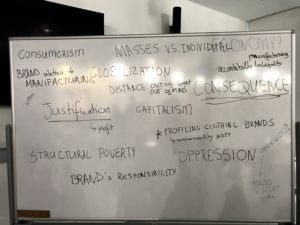I think this movie was a great intro to this class. I’ve been interested in environmental science and sustainability but I didn’t really know how much of a role the fashion industry played. One of the points we discussed after the presentation today really struck me, weather or not people can afford to be ethical and sustainable. After learning about the negative impact buying fast fashion has I feel really guilty and I wish I could support more sustainable and transparent brands, however as a college student it’s not economically feasible. I definitely have more than enough clothes though, and my closet is full of many things I don’t wear, so my goal for the rest of this semester is to not buy any new clothes. One more issue that wasn’t mentioned in the movie or readings but that I noticed recently while I was traveling in Vietnam is that traditional ethnic clothing is also being lost. I went to a museum that had displays of tradition clothing for each of Vietnam’s 54 ethnic minorities but for many of them the outfit on display was one of the last existing pieces. Most of the younger generations wear all the big fashion brands and nobody remembers how to make the traditional clothing anymore.
My main role for our presentation was to talk about the consequences of the current fashion system. It’s one thing to just hear the facts but I think what the movie captures really well is showing the emotions of the people in countries like Bangladesh who are affected first hand. Justifying sweatshops becomes a lot harder once you can actually see the people who work there and get to know them a bit. If more people could see this film and be educated about the issues there might be a strong enough push to actually force the fast fashion brands to change, but we have to hold them accountable. Clothes shouldn’t be worth less than a sandwich but more than a life.
